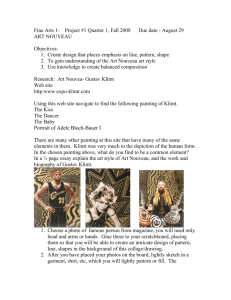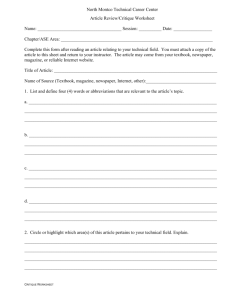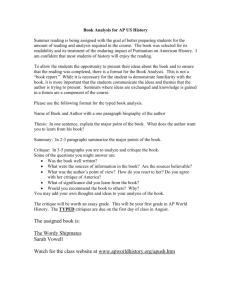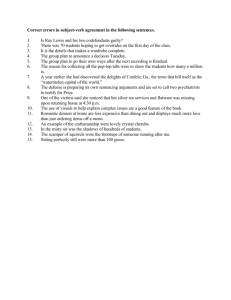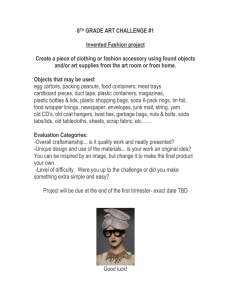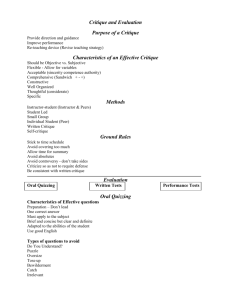Art in the Multi
advertisement
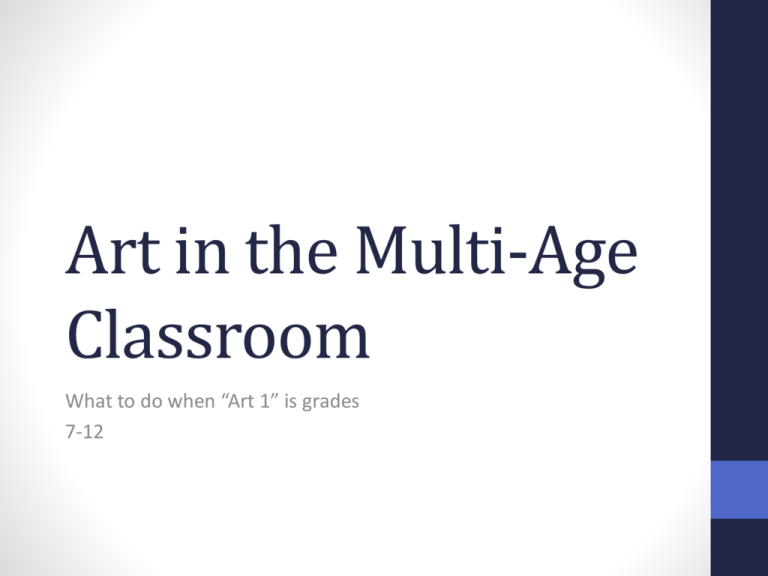
Art in the Multi-Age Classroom What to do when “Art 1” is grades 7-12 The Problem(s) Despite “Art 1” being the first art class students have taken since Elementary School, students of different ages have different ability levels and maturity levels. Admin thinks that 12 thru 18 year olds should be taught the same material and be held to the same standards because they are in the same class. The reality is that they have inherently different skills and reasons for being there. The National Standards are grouped for grades 5-8 and 9-12! I have to factor this in when writing lesson plans. The age range affects the material that can be taught. What is appropriate for an 18 year old may not be appropriate for a 12 year old. More problems The kids hate it! The older ones think they are in daycare, and the younger ones are scared to death of the older ones. Some older students are taking Art 1 to get the graduation credit, and have less than ideal motivation in class. The younger ones watch what the older ones do! I’m sure you can think of more! The Challenge(s) and possible solutions • Create rubrics or other grading criteria that is the same for all students in Art 1, yet factors in their individual ages and ability levels. • The wording has to be specific enough so that the students understand how they will be graded, yet general enough to allow for ability ranges. Don’t “water down” material for younger students, and don’t totally overwhelm the younger ones by making much too complicated for them, but give challenging problems for the students to solve at the level they are at. • Points should be given for both the understanding of the concepts, as well as the technical aspects of the artwork. This can be done for any grade. • I usually have the class decide with me how some of the points will be given for recurring, more general rubric items. For example, “craftsmanship.” • There is always a written self critique. This is required for Common Core anyway, but helps to show student understanding. Project examples • I have chosen 4 projects and their different rubrics. They all have similarities (the general parts, craftsmanship, e.g.) and differences (the project specific parts) • I have not shown the entire lesson plan here but would be happy to share them. Art Nouveau project The rubric: Classic Art Nouveau style is incorporated: up to 10 points • Subject matter • Details • Color choices Unique modern twist: up to 10 points *Risk taken (did you choose the absolute easiest thing, or did you choose something more challenging?): up to 5 points *Craftsmanship: up to 5 points Self critique: up to 5 points Total: 35 points *I do lots of discussion about what good craftsmanship looks like with my students. Many projects include the students telling me how they would get 5 points for craftsmanship. We also discuss what would be an easy project and what would be a more challenging project. I always say “good art takes time!” don’t rush through it. Regan, grade 7 Art nouveau style: 9 Unique modern twist: 10 Risk taken: 5 Craftsmanship:5 Self critique: 5 Total: 34 Neida, grade 10 Art Nouveau: 10 Unique modern twist: 5 Risk taken: 5 Craftsmanship: 5 Self critique:1 Total: 26 Forrest, grade 8 Art nouveau: 10 Unique modern twist: 8 Risk taken: 5 Craftsmanship: 4 Self critique: 5 Total: 32 Timo, grade 10 Art Nouveau: 10 Unique modern twist: 8 Risk taken: 4 Craftsmanship: 3 Self critique: 4 Total: 29 Metamorph Project Rubric: 5 changes occurred: up to 5 points Detail drawing part: up to 10 points • Craftsmanship/ control • Originality Personal symbol (this is discussed in a written part. We discussed as a class what this means and how to get the 5 points): up to 5 points Risk/ challenge of subject: up to 10 points Self critique: up to 5 points Total: 35 points Mac, grade 10 5 changes: 5 Detailed drawing area: 10 Personal symbol: 3 Risk/ challenge: 10 Self critique: 3 Total: 31 Jai, grade 9 5 changes: 5 Detailed drawing area: 7 Personal symbol: 5 Risk/ challenge: 10 Self critique: 5 Total: 32 Sophie, grade 7 5 changes: 5 Detailed drawing area: 10 Personal symbol: 3 Risk/ challenge: 10 Self critique: 5 Total: 33 James, grade 7 5 changes: 5 Detailed drawing area: 10 Personal symbol: 0 Risk/ challenge: 8 Self critique: 5 Total: 28 Brianna, grade 8 5 changes: 5 Detailed drawing area: 7 Personal symbol: 1 Risk/ challenge: 8 Self critique: 5 Total: 26 Two point perspective observation drawing Perspective is correct: up to 10 points Values are correct: up to 10 points Self critique: up to 5 points Famous example and worksheet: up to 5 points Effort/ craftsmanship: up to 5 points Total: 35 points Bethany, grade 8 Perspective is correct: 10 points Values are correct: 10 points Self critique: 5 points Famous example and worksheet: 5 points Effort/ craftsmanship: 5 points Total: 35 points Duncan, grade 8 Perspective is correct: 10 points Values are correct: 10 points Self critique: 5 points Famous example and worksheet: 3 points Effort/ craftsmanship: 5 points Total: 33 points Ben, grade 10 Perspective is correct: 10 points Values are correct: 8 points Self critique: 3 points Famous example and worksheet: 2 Effort/ craftsmanship: 5 points Total: 28 points Adam, grade 7 Perspective is correct: 10 points Values are correct: 6 points Self critique: 5 points Effort/ craftsmanship: 5 points Famous example and worksheet: 5 Total: 31 points Sketchbook Projects In addition to the in-class project, there is always a sketchbook project that is homework. The project is related to the in class version, but has a twist. If the student can create the assignment correctly, with the twist, then they have further proven (or disproven!) that they understand the concepts of the lesson. Because there is a sketchbook project for every in-class project, the rubric is general and is the same for each one. The students know exactly how these are graded every time. Sketchbook projects tend to make or break a students grade for a quarter or semester, even though they are worth less than larger, inclass assignments. Students tend to work extra hard, or rush through them. That is why points for effort are higher. Correct use of the technique or concept: up to 5 points Originality: up to 3 points Effort/ craftsmanship: up to 7 points Total: 15 In class project Sketchbook 2 color linoleum block print A design for a 5 color block 2 point perspective drawing (inside corner) 2 point perspective drawing (outside corner) Assemblage sculpture Incorporating a found object into a drawing Re-create the values of a photo Use white pencils on black paper Ryan, grade 11 (using a found object) Correct technique or concept: 5 points Originality: 3 points Effort/ craftsmanship: 7 points Total: 15 points Jared, grade 7 (using a found object) Correct technique or concept: 5 points Originality: 2 points Effort/ craftsmanship: 5 points Total: 12 points Charisse, grade 12 (using a found object) Correct technique or concept: 5 points Originality: 3 points Effort/ craftsmanship: 4 points Total: 12 points Josue, grade 9 (using a found object) Correct technique or concept: 5 points Originality: 2 points Effort/ craftsmanship: 3 points Total: 10 points Finally… • In all of our schools, there are challenges. It is our job to figure out how to not just deal with these challenges, but to successfully work with them. This is how I have figured out how to work with the challenge I was given at my school. Thank you for listening! Contact Info: Caryn Bopp cbopp@northlandprep.org Power point and lessons shown can be found at: http://www.northlandprep.org/ teachers/caryn-bopp/
